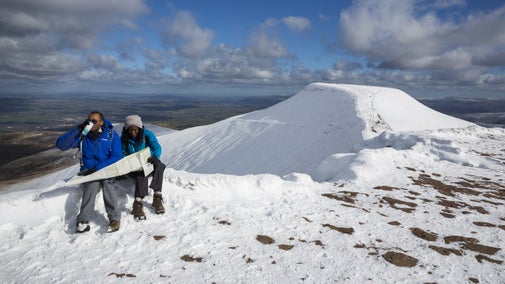Southgate, Hunts Bay and Pwll Du circular walk
Wales
A beautiful but challenging walk along the South Gower coast, passing over clifftops and down through wooded valleys. Enjoy stupendous views, discover rare and fascinating flora, and root around an Iron Age hillfort.
Start point
Southgate car park, grid ref: SS554874Trail information
*A fairly challenging walk with some steep sections. For further details, please see Terrain section.
**Uneven surfaces and narrow clifftop paths throughout the trail. For further details, please see section marked Access.
***Dogs should be kept on close lead. For further details, please see section marked Facilities.
More near here
Rhosili headland walk
Journey out along one of Wales's most famous cliffs with views of the golden sand of Rhosili and the rugged limestone rocks of the South Gower Coast.

Bishopston Valley walk
Discover caves, underground rivers and ancient woodland on this challenging walk through a hidden valley in Gower, Wales.

Rhosili Down, Hillend and beach walk
A challenging walk to the highest point on Gower and a descent onto a three-mile-long sandy beach. Burial chambers, radar stations and shipwrecks, are some of the highlights you will pass along the way.

Circular walk around the Vile, Rhosili
Explore the wildlife-rich fields of the Vile, an example of medieval strip farming now restored and farmed to create new habitats, backed by views of Rhosili Bay.

Get in touch
Our partners

We’ve partnered with Cotswold Outdoor to help everyone make the most of their time outdoors in the places we care for.
You might also be interested in
Visiting Rhosili and South Gower Coast
A scenic spot for coastal walks, water sports and wildlife. With 3 miles of sandy beach there’s plenty of space for the whole family to play in the sand or fly a kite.

Eating and Shopping at Rhosili
Rhosili Bay, Gower, the site to one of our most unique shopping locations. With views across the 3 mile sandy beach, it’s a place like no other. With plenty of local treats and to enjoy or take back home. We also have plenty of choice for any last minute purchases to really make your day out the best it can be.

Walking in Wales
Explore wide open landscapes, gentler coastal strolls or energetic hikes for something a little more challenging. We've rounded up some of the best places to walk in Wales.

Cotswold Outdoor: our exclusive walking partner
Learn about the National Trust’s ongoing partnership with Cotswold Outdoor. Find out how they help us care for precious places and the exclusive discount available for National Trust supporters.

Staying safe at National Trust places
The special places in National Trust care sometimes come with a few risks for visitors, be it coastline or countryside. Find out how to keep safe throughout your visits.

Follow the Countryside Code
Help to look after National Trust places by observing a few simple guidelines during your visit and following the Countryside Code.


